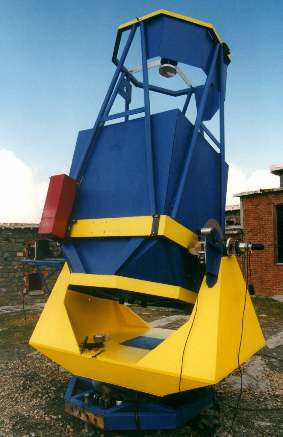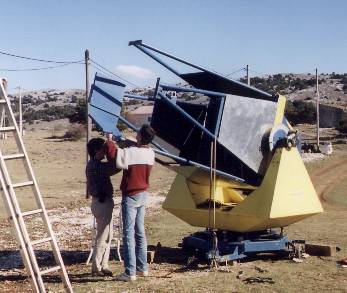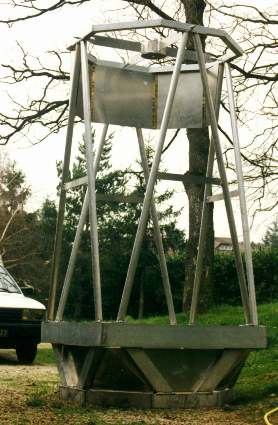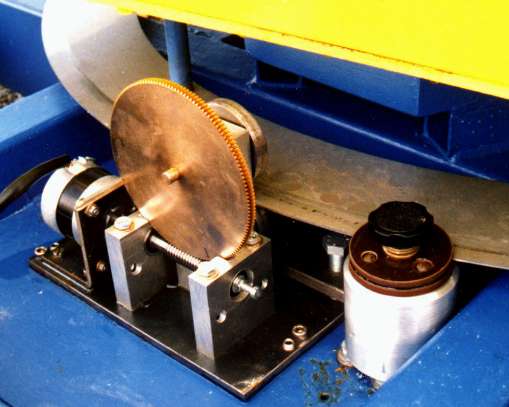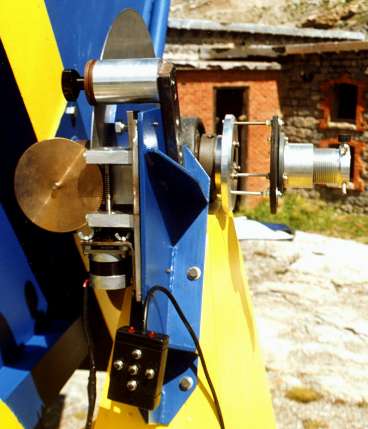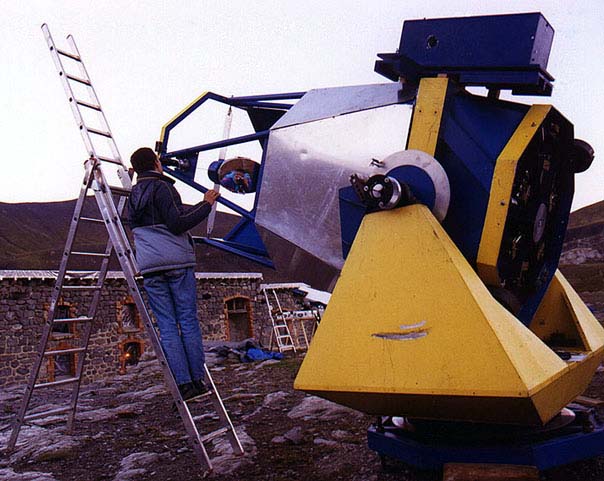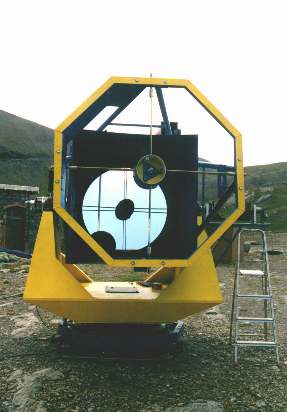| This
instrument is simply beyond what is considered standard. It's
beyond any standard by its size and also beyond normal standards by its
optical quality. Its mounting belongs to an association,
ADIA and the optical parts to David Vernet. Its manufacture
started in 1993, but like any telescope, it is in a constant evolution.
The primary mirror has a diameter of 1 meter (39.4"), which is not
commonly found and the focal length is 118", an F/3 focal ratio, which
is even more unusual! The weight of the primary mirror is 221
lbs. It is a molded thin Pyrex meniscus disk of 2.8" thick. Is on
a hybrid astatic mirror cell of 27 points. This molded shape
enables it to keep its great optical quality. Once again, it's useless
to have a great mirror if its support is not of the same quality.
The secondary mirror blank, cut from 1.57" thick Pyrex material, is
also an astonishing optical part. Its small axis is 11.8" and its
long axis is 16.9", so it is also larger than many amateur primary
mirrors. It can be used as a Newtonian or with the addition of a third
5.9" mirror; focus can be reached at the Nasmyth or Coude focus through
the altitude axis.
|
|
|
|
The mount is also very impressive. The fork is made out of welded steel tubing 1.18" in diameter, .08" thick and is covered with an "aluminum skin". The fork assembly weight is about 264 lbs. About 50 polyurethane cans of expanded foam were necessary to fill it. The aluminum truss poles are 2" in diameter and are joined in pairs in order to compose an "A" shape and thus setup is easier. It is a true "serrurier truss" because the mirror cell is also fixed with 8 tubes. Its weight without optics is approximately 660 lbs. If one adds the mirror cell and the optic, the weight of the complete optical tube is around 1100 lbs. In order to move such a monster, because it is a mobile telescope, the base of the instrument receives a car's axle. That gives the instrument a total weight of around 2200 lbs. The assembly takes a rather significant time to set up but careful construction the whole unit is optimized upon assembly.
|
|
The motorization is carried out thanks to a system developed by the ADIA association. A notebook computer controls the 3 stepper motors, including one intended for the de-rotator, which is necessary to take pictures in the Coude/Nasmyth mode.
|
|
When one is close of the instrument, one is astonished by his compactness. It is certainly of an imposing size, but its optics at F/3 makes it more accessible than a comparably sized instrument, often equipped with a mirrors of F/4.5 or 5 ratios. The only drawback of this F/3 system is the need for careful collimation of the instrument and the use of a Paraccor. When aimed at the zenith, the eyepiece is at around 10.5 ft above the ground. But what is its performance on the sky? On this website, articles about telescopes don't quite describe the views through this instrument, but it's a telescope with a view that is also beyond a standard.
|
|
Once at the eyepiece, it's true that the emotion of the view is of the same scale as the monster. Many NGC's which are usually small blurry spots become brilliant preys, often more beautiful than the best messier through a 20-inch. M13 is a fabulous spectacle, throughout the entire field; thousands of small pinpoint stars are spread on a black velvet background. The small IC galaxy, which is between M13 and NGC-6207, is much fainter but is perfectly visible with direct vision. The traditional objects are hardly recognizable. Thanks to the relatively large field for such an instrument, the Veil nebula and an 0III filter can hold the observer at the eyepiece for hours. Really, this large an aperture still gives a great benefit to the view compared more traditional 20" dobs. A clear, full magnitude threshold is easily reached. Stars in other galaxies, like M31 or M33, often of 18th magnitude, are easily visible using direct vision, a little like bright condensation of our milky way with dozens of bright points. On Orion's M43, the night adaptation is simply lost, leaving, when one no longer looks through the eyepiece, a dark spot with the shape of the nebula's center on the retina! But most astonishing, is that with this telescope, which seems to be entirely dedicated to the deep sky, according to is aperture and F-ratio, offers exceptional performance on planets. Jupiter and Saturn are of such extreme contrast as to cut the breath, it is simply a space vision! From the excellent contrast offered by the optics, it seems that the planets literally float in front of the observer. The subtle colors of the planets are perfectly visible in all their subtlety. It's hard to believe that a 40" F/3, 30% obstructed Newtonian is also a very good instrument on planets but that's true. Its above-standard optical quality allows this.
|
|
Many thanks to David Vernet, Thierry Legault and Luc Arnold for pictures.
|

